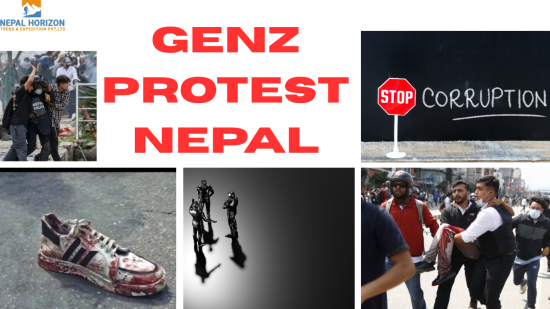Journey to Everest: Complete Base Camp Trek Guide
7th October 2025

Standing at the base of Mount Everest, watching the golden sunrise hit the world’s highest peak, is a moment that changes you forever. The Everest Base Camp trek is more than just a trail; it’s a journey into the heart of the Himalaya adventure, where every step brings you closer to nature, culture, and your inner strength.
If you’ve ever dreamed of exploring the Nepal trekking trails, this Everest Base Camp trek guide is your perfect companion. Let’s explore everything — from the best time to visit, route, cost, and preparation — to help you plan your Everest Base Camp adventure with confidence.
1. Why the Everest Base Camp Trek Is So Special
The Everest Base Camp (EBC) trek is the world’s most iconic trekking route, leading you to the foot of the tallest mountain — Mount Everest (8,848.86 m). Unlike other trails, this trek offers a perfect blend of adventure, breathtaking scenery, and cultural richness.
As you trek through the Khumbu region, you’ll walk alongside ancient monasteries, fluttering prayer flags, and warm-hearted Sherpa villages. The trail connects you deeply with Nepal’s mountain spirit — something only those who walk it truly understand.
Everest Base Camp Trek Highlights:
- Trek to the base of the world’s highest mountain
- Fly to Lukla — a thrilling airstrip nestled in the Himalayas.
- Panoramic views of Everest, Lhotse, Ama Dablam, and Nuptse
- Sherpa culture and Himalayan hospitality
- Breathtaking sunrise from Kala Patthar
- Monastery visits and spiritual energy of Tengboche
Nepal Horizon Trek offers customized EBC trek packages to make your journey seamless and memorable.
2. Best Time to Visit Everest Base Camp
Timing is everything in the Himalayas. The weather at Everest Base Camp can make or break your trekking experience.
Spring (March – May)
This is one of the best seasons for the EBC trek. The trails are filled with blooming rhododendrons, clear skies, and mild temperatures. It’s also the time when Everest expedition teams prepare for their summit — so the Base Camp is lively and energetic.
Autumn (September – November)
Crystal-clear views, comfortable weather, and vibrant mountain scenes make autumn another peak season. Trekkers enjoy breathtaking visibility and festive cultural vibes in the villages.
Winter (December – February)
Expect cold temperatures and snow, but fewer crowds. If you can handle the chill, winter offers peaceful solitude and spectacular snowy landscapes.
Monsoon (June – August)
Not ideal for most trekkers due to rain and cloud cover, but if you enjoy quiet trails and adventure, it’s possible with proper gear and guidance from professionals like Nepal Horizon Trek.
3. Duration and Everest Base Camp Trek Itinerary (12–16 Days)
A typical Everest Base Camp itinerary takes around 12 to 16 days, depending on your pace and acclimatization schedule. Here’s a classic 14-day EBC trek plan:
Day 1: Arrival in Kathmandu (1,400 m)
Welcome to Nepal! Explore Kathmandu’s historic streets and prepare for your adventure briefing.
Day 2: Fly to Lukla (2,860 m) – Trek to Phakding (2,610 m)
Your journey begins with a thrilling 35-minute flight to Lukla, followed by a gentle trek to Phakding through pine forests and Sherpa villages.
Day 3: Phakding to Namche Bazaar (3,440 m)
Cross suspension bridges, follow the Dudh Koshi River, and climb steadily to reach the vibrant Sherpa town of Namche Bazaar.
Day 4: Acclimatization Day in Namche Bazaar
Rest and explore. Visit the Everest View Hotel or hike to Khumjung village to adapt to the altitude.
Day 5: Namche Bazaar to Tengboche (3,860 m)
Enjoy stunning views of Ama Dablam as you trek to Tengboche, home to the region’s most famous monastery.
Day 6: Tengboche to Dingboche (4,410 m)
Descend through forests, cross the Imja River, and climb toward the open valley of Dingboche.
Day 7: Acclimatization Day in Dingboche
A short hike to Nangkartshang Peak offers fantastic views and helps with altitude adjustment.
Day 8: Dingboche to Lobuche (4,910 m)
The trail passes memorial stones for climbers who lost their lives on Everest, leading to Lobuche’s cold but charming village.
Day 9: Lobuche to Gorak Shep (5,140 m) – Everest Base Camp (5,364 m)
The big day! After a morning trek to Gorak Shep, continue to Everest Base Camp. Enjoy your long-awaited moment at the foot of the world’s highest peak.
Day 10: Hike to Kala Patthar (5,545 m) – Return to Pheriche
Early morning climb to Kala Patthar for unforgettable sunrise views of Everest, then descend to Pheriche.
Day 11–13: Return trek via Namche Bazaar to Lukla
Retrace your steps through the same picturesque villages.
Day 14: Fly back to Kathmandu
Celebrate your achievement and explore the city before your departure.
4. Trekking Route and Major Stops
The Everest Base Camp trekking route begins from Lukla and passes through several scenic villages. Each stop has its own charm:
- Lukla: Gateway to the EBC trek, known for its thrilling airstrip.
- Namche Bazaar: The Sherpa capital, full of cafes, shops, and mountain vibes.
- Tengboche: Home to Tengboche Monastery and majestic views of Ama Dablam.
- Dingboche: Known for its open valleys and acclimatization stop.
- Lobuche & Gorak Shep: High-altitude villages leading to Everest Base Camp.
- Kala Patthar: The best viewpoint for sunrise and close-up views of Mount Everest.
5. Accommodation and Meals on the EBC Trek
During your Everest Base Camp experience, you’ll stay in traditional tea houses — small, family-run lodges that offer warmth, simplicity, and comfort.
Accommodation:
- Twin-sharing rooms with basic amenities
- Shared bathrooms (hot showers available for an extra fee)
- Cozy dining areas with a fireplace
Meals:
Expect hearty meals like Dal Bhat, noodles, pasta, and Sherpa stew. You can also enjoy hot tea, coffee, and occasional desserts. Staying hydrated is essential, so drink plenty of boiled or filtered water.
🍵 Pro tip: Try local Sherpa tea for warmth and energy during cold mornings.
6. Trekking Difficulty, Fitness, and Tips
The Everest Base Camp trek is considered moderate to challenging, mainly due to its altitude rather than technical difficulty. Anyone with average fitness and determination can complete it with proper preparation.
Fitness Tips:
- Begin physical training 2–3 months before the trek.
- Include cardio (hiking, jogging, cycling) and strength workouts.
- Practice walking with a backpack to build stamina.
Altitude Tips:
- Acclimatize properly — don’t rush.
- Stay hydrated and avoid alcohol.
- Listen to your guide and your body.
Guided treks with Nepal Horizon Trek ensure proper acclimatization and safety support.
7. Cultural Encounters and Sherpa Hospitality
The Everest Base Camp trek isn’t just about mountains — it’s about people. The Sherpa community of the Khumbu region is known for its warmth, resilience, and spirituality.
You’ll pass through villages decorated with prayer wheels and mani walls, visit centuries-old monasteries, and experience Buddhist chants echoing through the mountains. These cultural encounters make your EBC trek deeply meaningful.
Interacting with locals teaches you more about courage, kindness, and balance than any guidebook ever could.
8. Safety, Permits, and Trekking Guidelines
Safety is crucial in the Himalayas. Always trek with licensed guides and ensure you have the right permits.
Required Permits:
- Sagarmatha National Park Entry Permit
- Khumbu Pasang Lhamu Rural Municipality Permit
Both can be arranged easily by Nepal Horizon Trek before your journey begins.
Safety Tips:
- Always follow your guide’s instructions.
- Carry a first-aid kit and altitude medicine.
- Keep travel insurance that covers high-altitude trekking.
- Stay updated on weather and flight conditions.
9. Gear and Packing Tips
Packing smart can make your trek comfortable and safe. Here’s what to bring:
Essential Gear:
- Trekking boots (waterproof)
- Down jacket and thermal layers
- Sleeping bag (rated to -15°C)
- Trekking poles
- Gloves, hat, and buff
- Sunglasses and sunscreen
- Water purification tablets
- Power bank and flashlight
Pack light but don’t skip essentials — every gram counts at high altitude.
10. Cost of the Everest Base Camp Trek
The EBC trek cost varies based on duration, comfort, and services. On average:
- Standard trek: USD 1,200 – 1,800 per person
- Luxury trek: USD 2,000 – 3,500 per person
This typically includes permits, guides, porters, accommodation, meals, and internal flights.
Nepal Horizon Trek offers customized Everest Base Camp trek packages that suit every traveler’s needs — from budget-friendly to luxury options.
11. Travel Recommendations
- Arrive in Kathmandu at least two days before your trek to prepare and check your gear.
- Book flights to Lukla early, as they fill up fast in peak season.
- Choose a licensed trekking company in Nepal for safety and support.
- Respect local culture — always walk clockwise around monasteries and stupas.
🌏 Plan your Everest Base Camp adventure with Nepal Horizon Trek today! Experience the Himalayas with trusted guides who make your journey truly unforgettable.
12. Conclusion
The Everest Base Camp trek isn’t just a trail — it’s a transformative journey. It challenges your limits, rewards your spirit, and immerses you in the grandeur of the Himalaya adventure. Every step from Lukla to Kala Patthar tells a story — one that stays with you long after you return home.
If you’re ready to experience the majesty of Everest, the warmth of Sherpa culture, and the beauty of Nepal trekking, then your moment is now.
Nepal Horizon Trek is here to make your dream a reality.
Start your journey to Everest Base Camp today!
Frequently Asked Questions (FAQs)
1. How demanding is the trek to Everest Base Camp?
It’s a moderate to challenging trek due to high altitude, but with preparation and proper acclimatization, it’s achievable for most trekkers.
2. What is the best time for the EBC trek?
Spring (March–May) and Autumn (September–November) are the best seasons for clear views and pleasant weather.
3. Do I need prior trekking experience?
No, but basic fitness and hiking experience help. Nepal Horizon Trek guides beginners safely through the journey.
4. Are there ATMs and Wi-Fi on the trail?
Yes, ATMs and Wi-Fi are available in Namche Bazaar and some villages, though connections may be slow and costly.
5. What permits do I need?
You’ll need the Sagarmatha National Park Permit and Khumbu Pasang Lhamu Rural Municipality Permit, both arranged by your trekking agency.
6. Can I do the EBC trek solo?
Solo trekking is allowed, but hiring a guide or joining a group ensures safety, better navigation, and cultural insights.
Ready for your next great adventure? Contact Us Now
👉 Plan your Everest Base Camp trek with Nepal Horizon Trek — where every step becomes a story.
Recent From Blogs

7th October 2025

27th September 2025
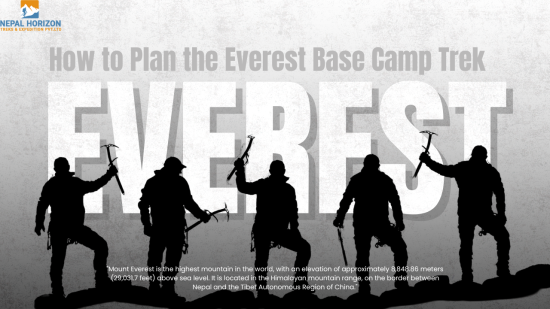
25th September 2025

22nd September 2025
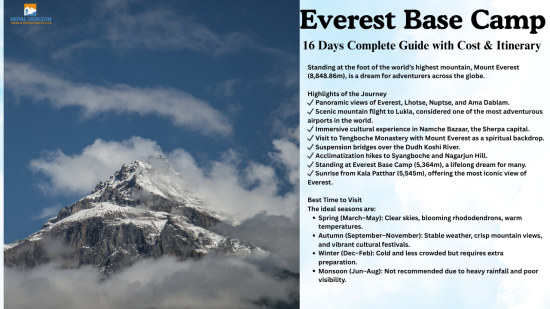
20th September 2025

17th September 2025
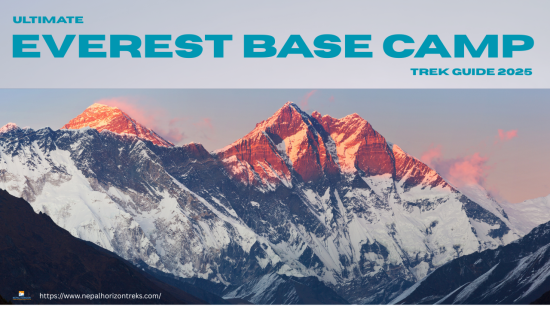
15th September 2025
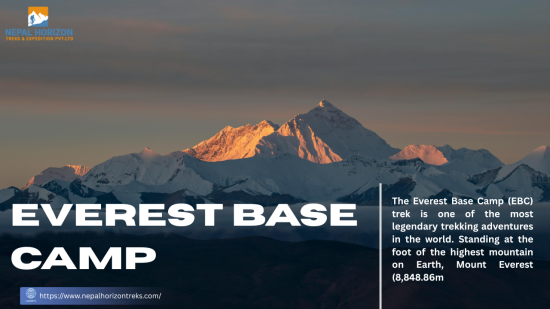
13th September 2025
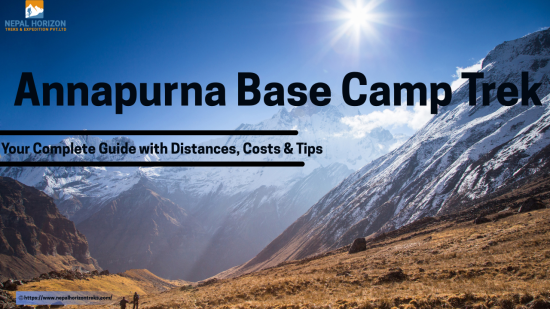
11th September 2025
